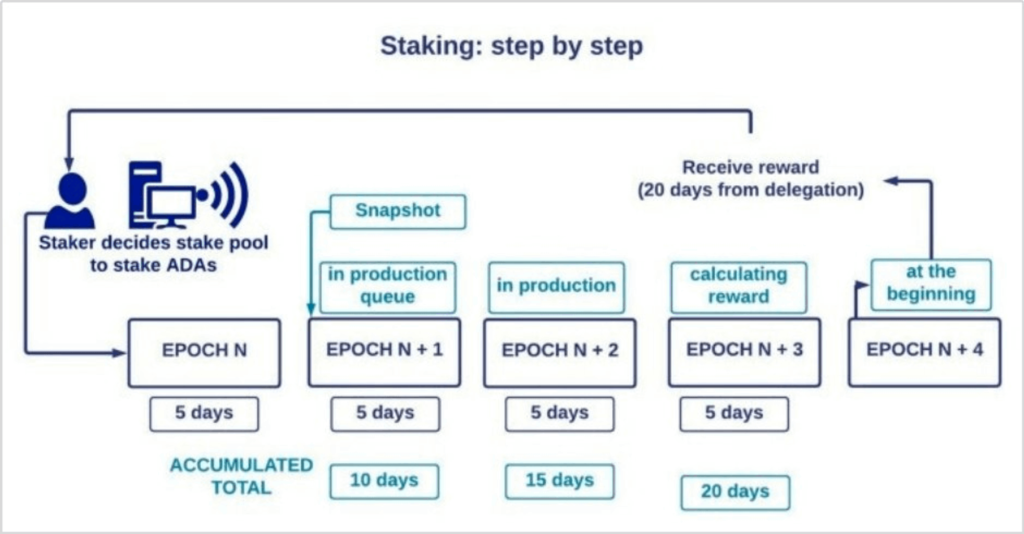What Is Epoch in Cryptocurrency?

In the dynamic world of crypto, an understanding of the mechanisms that underpin blockchain networks is critical. One concept that plays a vital role in blockchain is the “epoch,” which is essential to many activities in the blockchain network. In the following article, we’ll take a closer look at what an epoch is, how it works, and why it’s important for both investors and crypto developers.
Article Summary
- ⏰ An epoch serves as a time period that marks certain events in a blockchain network, such as the creation of blocks.
- 🚨 An epoch also has the ability to protect blockchain data from manipulation by malicious actors and helps to process data more quickly and efficiently.
- ⏳ The length of an epoch can vary between blockchains; for example, Bitcoin’s epoch lasts 10 minutes, Ethereum’s lasts only 12 seconds, and Cardano’s can last five days.
- ✍🏻 Cardano (ADA) is one of the proof-of-stake-based blockchains that heavily incorporates the concept of epochs into its operations.
What Is An Epoch?
In cryptocurrency, an epoch refers to a period of time used in a blockchain protocol or network to mark a specific event within the blockchain network. Such events include the creation of blocks and the addition of new blocks to the blockchain. Epochs are also used to mark when incentive rewards are distributed. This occurs in blockchains that use the proof-of-stake (PoS) consensus mechanism to validate transactions, such as Cardano (ADA), Solana (SOL), and Tron (TRX).
What is the duration of an epoch in Crypto?
The length of an epoch is determined by each blockchain. In proof-of-work (PoW) blockchains, the duration of an epoch depends on the time it takes for selected nodes to solve mathematical problems and add new blocks to the network. The duration is also affected by the size of the blockchain and its consensus protocol. Using PoW as an example, the well-known Bitcoin has epochs lasting 10 minutes. In contrast, Ethereum has shorter epochs of only 12 seconds.
How Does Epoch Work?
An epoch consists of multiple slots, which are defined as the smallest units of a blockchain that contain a block. Within each slot, the network can designate a node to act as a slot leader. This slot leader can then decide to create a block that stores new transactions that have been verified by selected network participants. It’s worth noting that the way the validator works within an epoch is unique to each blockchain.

An example of epoch usage is in the Cardano (ADA) network. Cardano is one of the world’s largest proof-of-stake-based blockchains. It employs Ouroboros Praos, a specialized proof-of-stake (PoS) consensus protocol, which divides the network’s epoch into five-day slots. These five-day epochs are further broken down into 20-second blocks, with each epoch comprising 432,000 slots.
At the onset of each ADA epoch period, a snapshot is taken to display how the coins used for staking in the previous epoch were distributed. This snapshot determines the amount of stake entering a pool and who will be the slot leader responsible for creating a block. The fixed cost to operate a Cardano staking pool is approximately 340 ADA per epoch.
Uses of Epochs in Cryptocurrency
Epochs have multiple uses in crypto, playing a vital role in the life of a blockchain, including:
2. Ensuring All Nodes Agree on Block Creation Schedule
The next role of the epoch is to ensure that all network nodes agree on when a particular block was created. Often, when a new transaction block is created, some nodes in the network may be offline. The epoch function becomes critical here because it uses a fixed time span, allowing nodes to easily verify when a block or group of blocks was created and how many blocks were created during their offline period.
3. Preventing and securing blockchain data
Another role of the epoch in crypto is to protect the network from malicious actors who want to manipulate the data stored on the blockchain. Such attacks are aimed at stealing the funds stored there. Epochs help thwart these attacks by sealing information at the end of each epoch. In addition, epochs ensure that blockchain information remains immutable by guaranteeing that only one set of validators is active on the network at any given time. Furthermore, epochs can prevent data inconsistencies caused by forks. To learn more about What Fork means in Cryptocurrency?, check out the following article.
4. Epoch in staking
Epochs are also used in staking to determine when staking rewards should be distributed to investors. For example, Cardano distributes payouts every four epochs, but other cryptocurrencies may have different epoch lengths.
Conclusion
After understanding what an epoch is and its central role in maintaining cryptographic networks, the epoch emerges as a highly valuable metric, especially for blockchain developers and users. Epochs provide a straightforward method for scheduling events and protecting the network from various malicious attacks, ensuring that all network participants maintain a consistent understanding. Each blockchain utilizes epoch in different ways to maximize efficiency and speed according to their own standards.
References
- Phemex, What Is an Epoch in Crypto?, accessed on 5 October 2023.
- CNBCTV18, Explained: Epochs in blockchain and why we need them, accessed on 5 October 2023.
- Eystein Hansen, Staking: Delegation in Cardano Proof-of-Stake Model Explained, nbx, accessed on 5 October 2023.
Share


